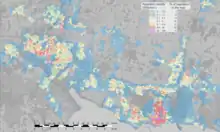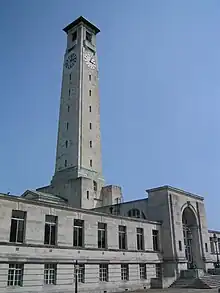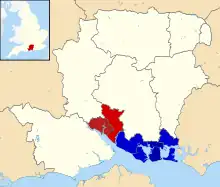South Hampshire
South Hampshire is a term used mainly to refer to the conurbation formed by the city of Portsmouth, city of Southampton and the non-metropolitan boroughs of Gosport, Fareham, Havant and Eastleigh in southern Hampshire, South East England. The area was estimated to have a population of over 1.5 million in 2013.[1] It is the most populated part of South East England excluding London. The area is sometimes referred to as Solent City particularly in relation to local devolution,[2] but the term is controversial.[3][4]

History
Harold Wilson's Labour government commissioned town planner Colin Buchanan in 1965 to study the region. He found a region of growing economic importance, in desperate need of proper planning to avoid unplanned sprawl, and suggested the construction of a modernist urban area between Southampton and Portsmouth.[5] However this was resisted by local authorities who occupied the proposed development sites, and Buchanan's plans were never put into effect.[1]
Instead, as a result of high-tech industry and services, the area was able to grow largely without overall planning to become perhaps the most densely populated region of the UK.[1] In the late 20th century mass manufacturing of ordinary commodities declined, leaving several town and city neighbourhoods impoverished and suffering unemployment; however by the early 21st century high income and retirement properties came to dominate some neighbourhoods, particularly close to universities, and many suburbs and exurbs. Centrally planned building programmes included large estates, connected by new road networks, for commercial and residential use by Hampshire County Council's architects, led by Colin Stansfield Smith. Otherwise development has tended to be on a case-by-case basis for retail parks, business parks and housing.[1]
The Solent Local Enterprise Partnership (LEP) is a collaboration between local authorities, universities and businesses set up in 2011 by the Department for Business, Innovation and Skills.[6][7] Different departments of the Solent LEP are distributed across the area, with its 'Growth Hub' being based in Southampton.[8] On 12 November 2013 the government announced the second wave of City Deals, with a successful joint bid of Southampton and Portsmouth providing £953 million of investment into the Solent LEP.[9]
Various attempts at a South Hampshire or Solent City devolution deal have been made, but saw minor local resistance, stemming from the Southampton-Portsmouth rivalry, as well as from the more rural Isle of Wight.[10][11] Whilst the proposal did otherwise see continued support, particularly from councillors,[12] by 2018 talks with the government had stalled.[10][13] More recent proposals have included southeast Dorset, that is Bournemouth, Christchurch and Poole (BCP). After another bid was submitted in 2021, Gerald Vernon-Jackson claimed the government were "keen" on including BCP in a potential deal.[14] A November 2022 report by BCP Council suggested a Central South deal as an alternative to a Pan-Hampshire deal with BCP tacked on.[15]
Geography


The region can be subdivided into two conurbations, one centred around Southampton and one around Portsmouth. Most of the area is in the Hampshire districts of Gosport, Fareham, Havant, Eastleigh, Portsmouth and Southampton. All of these districts have high population densities, with Portsmouth and Southampton being the most densely populated districts in England outside Greater London.[16] Other parts of the area are in the Test Valley, East Hampshire, City of Winchester and New Forest districts, all of which have lower population densities. Small parts of the area are also in the West Sussex district of Chichester.
Climate
The climate is temperate oceanic, Cfb in the Köppen climate classification.
| Climate data for Southampton, elevation 3 m, 1981–2010 | |||||||||||||
|---|---|---|---|---|---|---|---|---|---|---|---|---|---|
| Month | Jan | Feb | Mar | Apr | May | Jun | Jul | Aug | Sep | Oct | Nov | Dec | Year |
| Average high °C (°F) | 8.4 (47.1) |
8.6 (47.5) |
11.1 (52.0) |
14.0 (57.2) |
17.5 (63.5) |
20.2 (68.4) |
22.4 (72.3) |
22.3 (72.1) |
19.8 (67.6) |
15.6 (60.1) |
11.7 (53.1) |
8.9 (48.0) |
15.1 (59.2) |
| Average low °C (°F) | 2.9 (37.2) |
2.6 (36.7) |
4.1 (39.4) |
5.7 (42.3) |
9.0 (48.2) |
11.7 (53.1) |
13.7 (56.7) |
13.7 (56.7) |
11.4 (52.5) |
8.9 (48.0) |
5.4 (41.7) |
3.2 (37.8) |
7.7 (45.9) |
| Average rainfall mm (inches) | 81.4 (3.20) |
58.3 (2.30) |
60.0 (2.36) |
50.7 (2.00) |
49.0 (1.93) |
50.4 (1.98) |
42.0 (1.65) |
50.4 (1.98) |
60.4 (2.38) |
93.8 (3.69) |
94.0 (3.70) |
89.2 (3.51) |
779.4 (30.69) |
| Average rainy days (≥ 1.0 mm) | 12.2 | 9.2 | 10.1 | 8.8 | 8.2 | 7.7 | 7.4 | 7.7 | 8.7 | 11.5 | 11.5 | 11.8 | 114.7 |
| Mean monthly sunshine hours | 63.3 | 84.4 | 118.3 | 179.8 | 212.1 | 211.2 | 221.8 | 207.7 | 148.1 | 113.0 | 76.6 | 52.9 | 1,689.3 |
| Source 1: Met Office (normals)[17] | |||||||||||||
| Source 2: Calculated from Met Office Data[18] | |||||||||||||
| Climate data for Southsea, Portsmouth 1976-2006 | |||||||||||||
|---|---|---|---|---|---|---|---|---|---|---|---|---|---|
| Month | Jan | Feb | Mar | Apr | May | Jun | Jul | Aug | Sep | Oct | Nov | Dec | Year |
| Average high °C (°F) | 9.6 (49.3) |
8.8 (47.8) |
10.6 (51.1) |
13.4 (56.1) |
16.8 (62.2) |
19.4 (66.9) |
21.8 (71.2) |
21.8 (71.2) |
19.3 (66.7) |
15.8 (60.4) |
12.0 (53.6) |
10.0 (50.0) |
14.9 (58.9) |
| Average low °C (°F) | 5.1 (41.2) |
4.3 (39.7) |
5.4 (41.7) |
6.4 (43.5) |
9.6 (49.3) |
12.3 (54.1) |
15.0 (59.0) |
15.0 (59.0) |
12.8 (55.0) |
10.9 (51.6) |
7.5 (45.5) |
5.9 (42.6) |
9.2 (48.5) |
| Average precipitation mm (inches) | 65 (2.6) |
50 (2.0) |
52 (2.0) |
42 (1.7) |
28 (1.1) |
40 (1.6) |
32 (1.3) |
43 (1.7) |
62 (2.4) |
81 (3.2) |
72 (2.8) |
80 (3.1) |
647 (25.5) |
| Average rainy days | 11.2 | 9.5 | 8.3 | 7.6 | 6.5 | 7.4 | 5.4 | 6.6 | 8.5 | 10.9 | 10.3 | 11.2 | 103.4 |
| Mean monthly sunshine hours | 67.9 | 89.6 | 132.7 | 200.5 | 240.8 | 247.6 | 261.8 | 240.7 | 172.9 | 121.8 | 82.3 | 60.5 | 1,919.1 |
| Percent possible sunshine | 26 | 31 | 36 | 49 | 51 | 51 | 54 | 54 | 46 | 37 | 31 | 25 | 41 |
| Source: Met Office[19] | |||||||||||||
| Climate data for a Rough climate of Havant | |||||||||||||
|---|---|---|---|---|---|---|---|---|---|---|---|---|---|
| Month | Jan | Feb | Mar | Apr | May | Jun | Jul | Aug | Sep | Oct | Nov | Dec | Year |
| Record high °C (°F) | 17 (63) |
16 (61) |
21 (70) |
25 (77) |
32 (90) |
36 (97) |
35 (95) |
37 (99) |
34 (93) |
27 (81) |
18 (64) |
16 (61) |
37 (99) |
| Average high °C (°F) | 8 (46) |
8 (46) |
11 (52) |
13 (55) |
17 (63) |
20 (68) |
23 (73) |
24 (75) |
19 (66) |
16 (61) |
11 (52) |
9 (48) |
15 (59) |
| Average low °C (°F) | 2 (36) |
1 (34) |
3 (37) |
5 (41) |
8 (46) |
11 (52) |
13 (55) |
14 (57) |
12 (54) |
8 (46) |
5 (41) |
3 (37) |
7 (45) |
| Record low °C (°F) | −10 (14) |
−9 (16) |
−8 (18) |
−4 (25) |
−1 (30) |
2 (36) |
5 (41) |
6 (43) |
0 (32) |
−4 (25) |
−6 (21) |
−8 (18) |
−10 (14) |
| Average precipitation mm (inches) | 85 (3.3) |
60 (2.4) |
62 (2.4) |
54 (2.1) |
50 (2.0) |
50 (2.0) |
42 (1.7) |
57 (2.2) |
74 (2.9) |
90 (3.5) |
85 (3.3) |
90 (3.5) |
799 (31.3) |
| Mean monthly sunshine hours | 65 | 85 | 130 | 200 | 230 | 235 | 255 | 230 | 170 | 125 | 90 | 60 | 1,875 |
| Source: Met Office[19] | |||||||||||||
| Climate data for Solent MRSC, (1981–2010 averages). | |||||||||||||
|---|---|---|---|---|---|---|---|---|---|---|---|---|---|
| Month | Jan | Feb | Mar | Apr | May | Jun | Jul | Aug | Sep | Oct | Nov | Dec | Year |
| Average high °C (°F) | 8.2 (46.8) |
8.2 (46.8) |
10.5 (50.9) |
13.2 (55.8) |
16.7 (62.1) |
19.2 (66.6) |
21.4 (70.5) |
21.4 (70.5) |
19.0 (66.2) |
15.5 (59.9) |
11.5 (52.7) |
8.7 (47.7) |
14.5 (58.1) |
| Average low °C (°F) | 3.4 (38.1) |
2.8 (37.0) |
4.5 (40.1) |
6.1 (43.0) |
9.2 (48.6) |
12.1 (53.8) |
14.2 (57.6) |
14.3 (57.7) |
12.2 (54.0) |
9.6 (49.3) |
6.2 (43.2) |
3.8 (38.8) |
8.2 (46.8) |
| Average rainfall mm (inches) | 68.8 (2.71) |
49.3 (1.94) |
51.6 (2.03) |
42.4 (1.67) |
43.4 (1.71) |
42.0 (1.65) |
44.5 (1.75) |
50.0 (1.97) |
53.7 (2.11) |
86.2 (3.39) |
83.2 (3.28) |
83.9 (3.30) |
699 (27.51) |
| Average precipitation days (≥ 1 mm) | 11.6 | 9.6 | 8.3 | 8.3 | 7.1 | 6.9 | 7.0 | 7.3 | 8.7 | 10.5 | 11.2 | 12.2 | 108.6 |
| Source: Met Office Solent MRSC, Thorney Island | |||||||||||||
Demography
The following Built-up areas fall inside the South Hampshire metropolitan area have a combined population of 1,086,786.
By council boundaries

The following populations is those of council boundaries that are considered part of the South Hampshire conurbation.
South Hampshire built-up area
In the 2001 census Portsmouth and Southampton were recorded as being parts of separate urban areas; but by the 2011 census they had merged to become the sixth largest built-up area in England, with a population of 855,569.[20] The new built-up area also merged with smaller urban areas called Locks Heath, Bursledon, Whiteley and Hedge End/Botley in the 2001 census.
| Urban subdivision[21] | Population | District | |
|---|---|---|---|
| (2001 census)[21] | (2011 census)[20] | ||
| Portsmouth | 187,056 | 238,137 | City of Portsmouth |
| Gosport | 69,348 | 71,529 | Borough of Gosport |
| Fareham | 56,160 | 42,210 | Borough of Fareham |
| Havant | 45,435 | 45,125 | Borough of Havant |
| Lee-on-the-Solent | 7,067 | Borough of Gosport | |
| Stubbington | 13,628 | 14,077 | Borough of Fareham |
| Waterlooville | 63,558 | Borough of Havant | |
| Total Portsmouth urban area population | 442,252 | ||
| Southampton | 234,224 | 253,651 | City of Southampton |
| Eastleigh | 52,894 | 78,716 | Borough of Eastleigh |
| Bishopstoke | 17,282 | Borough of Eastleigh | |
| Total Southampton urban area population | 304,400 | ||
| Locks Heath & surrounding villages | 36,452 | 43,359 | Borough of Fareham |
| Bursledon | 6,744 | 6,955 | Borough of Eastleigh |
| Whiteley | 2,195 | 3,236 | Borough of Fareham/City of Winchester |
| Total Western Wards population | 45,391 | 53,550 | |
| Hedge End | 21,174 | 25,117 | Borough of Eastleigh |
| Botley | 2,506 | 5,083 | Borough of Eastleigh |
| Total Hedge End/Botley population | 23,680 | 30,200 | |
| Horndean | 46,924 | East Hampshire/Borough of Havant | |
| Total South Hampshire built-up area population | 855,569 | ||
Notes:
- Portchester is included under the Portsmouth subdivision in the 2011 census whilst in the 2001 census it was part of the Fareham subdivision.
- Whiteley is included under the Locks Heath subdivision in the 2011 census.
- Stubbington and Lee-on-the-Solent formed a separate urban area according to the 2011 census.
- Bishopstoke and Horton Heath were included as part of the Eastleigh subdivision in the 2011 census.
- Botley was included as part of the Hedge End subdivision in the 2011 census.
- The Waterlooville subdivision was split between the Portsmouth subdivision and the Horndean subdivision for the 2011 census.
Other built-up areas
There are three other significant urban areas[22] in the area:[23]
| Urban subdivision[21] | Population
(2001 census)[21] |
Population
(2011 census)[20] |
District |
|---|---|---|---|
| Ashurst/Netley Marsh | 3,116 | 3,212 | New Forest District |
| Totton | 27,986 | 28,676 | New Forest District |
| Bartley | 2,281 | New Forest District | |
| Total Totton built-up area population | 31,102 | 34,169 | |
| Winchester built-up area | 41,420 | 46,074 | City of Winchester |
| Stubbington built-up area | 24,644 | Borough of Fareham/Borough of Gosport | |
| Hythe built-up area | 19,599 | 20,201 | New Forest District |
There are fourteen smaller urban areas also in the region:[23]
| Urban area[21] | Population | Population
(2011 census)[20] |
District |
|---|---|---|---|
| Colden Common | 3,249 | 3,419 | City of Winchester |
| Compton/Otterbourne | 2,261 | 2,569 | City of Winchester |
| Denmead | 5,788 | 6,107 | City of Winchester |
| Emsworth/Southbourne | 18,139 | 18,777 | Borough of Havant/Chichester District |
| Fawley/Blackfield | 13,775 | 13,712 | New Forest District |
| Hamble | 3,853 | 4,696 | Borough of Eastleigh |
| Hayling Island | 14,842 | 15,485 | Borough of Havant |
| Horton Heath | 2,223 | Borough of Eastleigh | |
| Kings Worthy | 4,292 | 4,901 | City of Winchester |
| Marchwood | 5,586 | 6,141 | New Forest District |
| Netley | 6,150 | 6,338 | Borough of Eastleigh |
| North Baddesley | 6,234 | 6,823 | Test Valley |
| Romsey | 17,386 | 17,161 | Test Valley |
Notes:
- Horton Heath forms part of the South Hampshire built-up area in the 2011 census rather than being a separate area.
- In the 2011 census the Fawley urban area was renamed the Blackfield built-up area.
- In the 2011 census the Kings Worthy urban area was renamed the Springvale built-up area.
- In the 2011 census the Hayling Island urban area was renamed the South Hayling built-up area.
Other towns in the area
Slightly further out there are many satellite towns that may not be directly attached to Southampton or Portsmouth, or necessarily in their Travel to work areas,[25] but are nonetheless still heavily reliant on the two cities for employment and services.
Places within the wider Portsmouth-Southampton Metropolitan area include:
| Settlement | County |
|---|---|
| Andover[26] | Hampshire |
| Bishop's Waltham[23][27] | Hampshire |
| Bognor Regis[26] | West Sussex |
| Brockenhurst | Hampshire |
| Chichester | West Sussex |
| Lyndhurst | Hampshire |
| Newport | Isle of Wight |
| Ryde | Isle of Wight |
| Salisbury[26] | Wiltshire |
See also
References
- Hatherley, Owen (27 February 2013). "How Labour got lost in Eastleigh's unplanned sprawl". The Guardian.
- Viccars, Andy (4 August 2003). "Transport Position Statement by Southampton and Fareham Chamber of Commerce and Industry" (PDF). Fareham Borough Council. Retrieved 1 August 2014.
- "MP blasts report as a revival of Solent City". Southern Daily Echo. 8 November 1999. Retrieved 1 August 2014.
- Fishwick, Ben (11 April 2014). "Residents rally as they fight plan to build 1,550 homes". The News (Portsmouth). Retrieved 30 November 2018.
He said: I do not want to live in "Solent City". I'd rather live in Fareham. I think we should keep the strategic gap.
- Phelps, Nicholas (2012). An Anatomy of Sprawl: Planning and Politics in Britain. Routledge.
The term Solent City is nowhere to be found in the South Hampshire Study and instead emerged as shorthand for the sheer horror felt by inhabitants and their political representatives over the emergence of a single functional urban region
- https://www.gov.uk/government/uploads/system/uploads/attachment_data/file/256460/2013111_Southampton_and_Portsmouth_City_Deal_Document_and_Implementation_Plans.pdf
- Emma Streatfield (7 October 2015). "Solent Local Enterprise Partnership has put in a bid to create a new enterprise zone near Southampton Airport that could create 6,000 jobs". Southern Daily Echo. Newsquest. Retrieved 7 September 2018.
- Ryan Platt (21 August 2017). "#19 Starting a business in Southampton". Startups. Retrieved 7 September 2018.
- "Southampton and Portsmouth get City Deal". BBC News. 12 November 2013. Retrieved 23 September 2018.
- "Coast joint authority plan dropped". BBC News. 30 June 2015. Retrieved 12 April 2020.
- "Solent Devolution". Isle of Wight News from OnTheWight. Retrieved 12 April 2020.
- "Devolution bid must be 'right for island'". BBC News. 6 October 2018. Retrieved 12 April 2020.
- "New Solent authority deal 'scrapped'". BBC News. 5 October 2018. Retrieved 12 April 2020.
- "EXCLUSIVE: Devo map finds new deals in sight as negotiations begin". LGC. 7 March 2022. Retrieved 11 April 2023.
- "Exploring the options for devolution to BCP Council" (PDF). Cabinet: BCP Council. 23 November 2022. Retrieved 11 April 2023.
- "Mid-Year Population Estimates, UK, June 2021". Office for National Statistics. 21 December 2022. Retrieved 18 October 2023.
- "Southampton W.C Climate Period: 1981-2010". Met Office. Retrieved 5 February 2013.
- "Long Term weather data". Met Office. May 2011. Archived from the original on 20 August 2011. Retrieved 20 March 2011.
- "Regional mapped climate averages". Met Office. November 2008. Retrieved 8 March 2011.
- "2011 Census - Built-up areas". ONS. Retrieved 20 July 2013.
- ONS (2004). Census 2001: Key Statistics for urban areas in England and Wales (PDF). HMSO. ISBN 0-11-621743-X.
- ONS (2004). Map showing urban areas (PDF). HMSO.
- Portsmouth-Southampton: largest cities and towns and statistics of their population Shows what is considered part of this metropolitan area
- Table KS01 Usual resident population
- "Travel to Work Areas". Office for National Statistics. Retrieved 1 August 2014. - see map on website
- "British urban pattern: population data" (PDF). ESPON project 1.4.3 Study on Urban Functions. European Spatial Planning Observation Network. March 2007. p. 119. Archived from the original (PDF) on 24 September 2015. Retrieved 22 February 2010.
- "South Hampshire Sub-region map" (PDF). Retrieved 9 May 2012.
